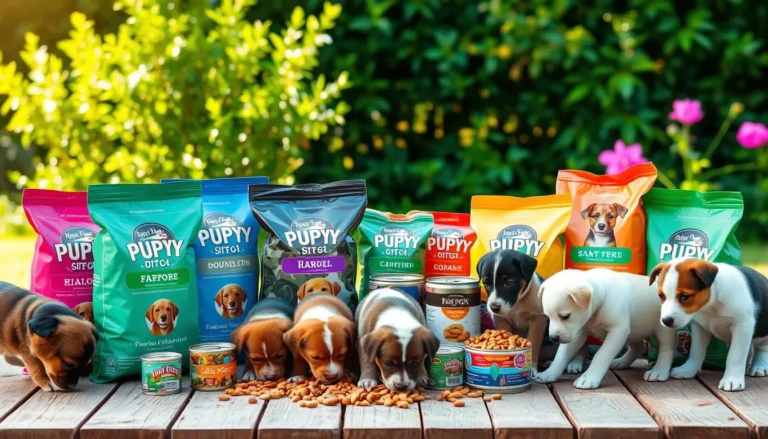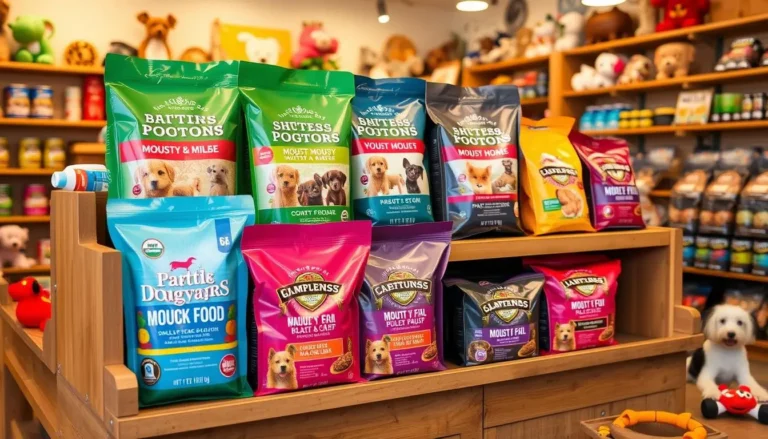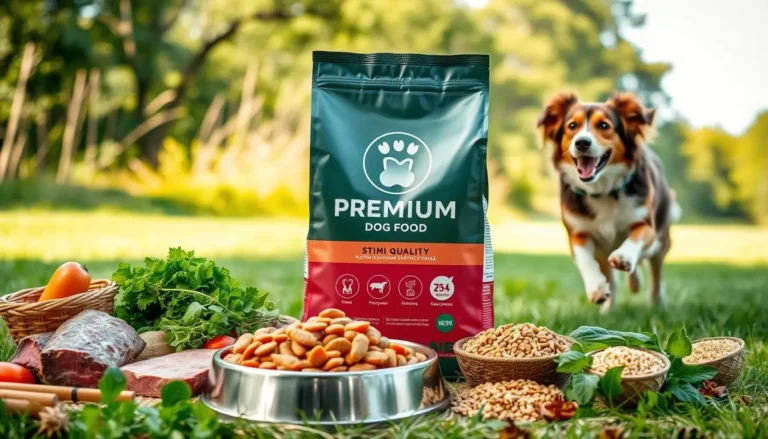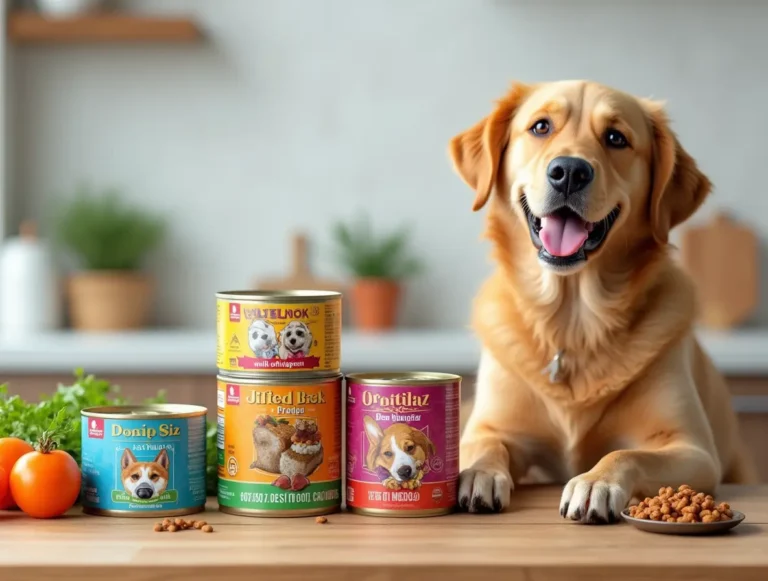Best Wet Dog Food: The Ultimate Guide to Choosing the Perfect Option for Your Dog in 2025
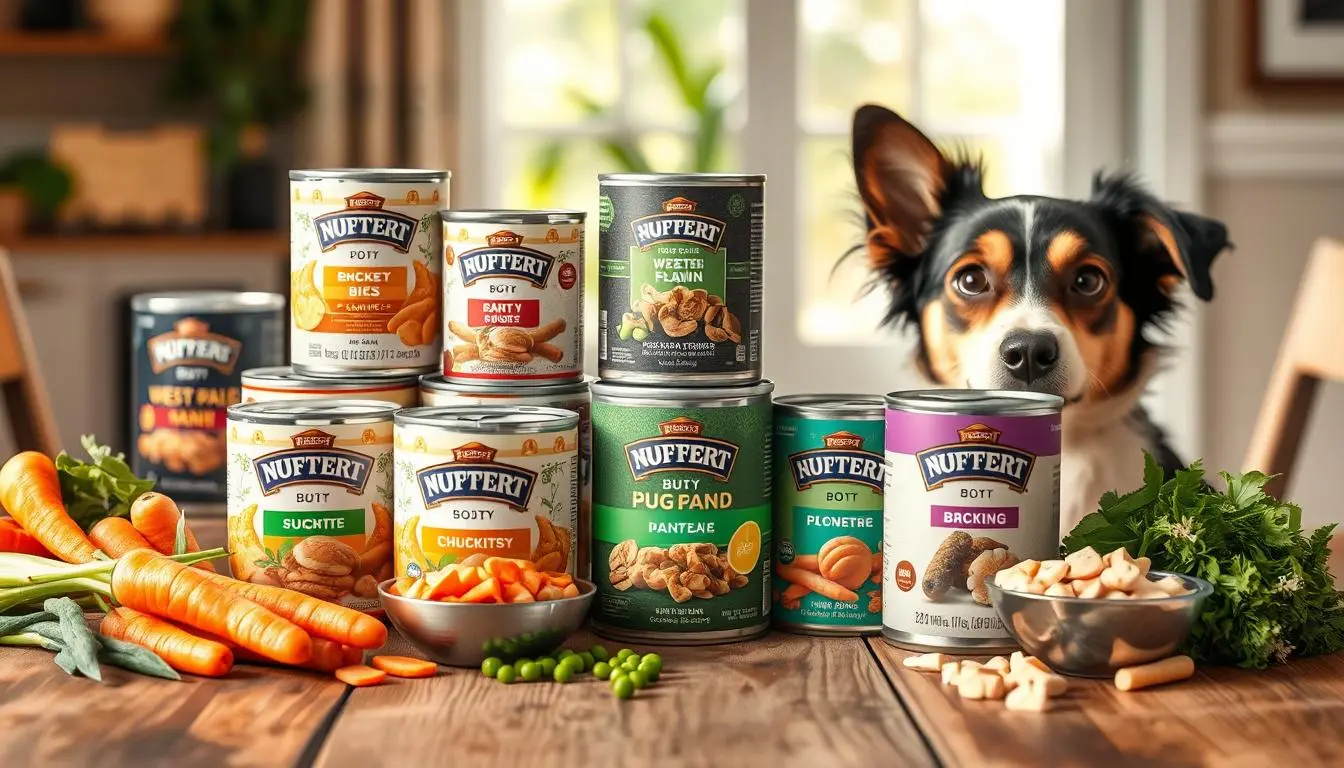
Finding the right best wet dog food can greatly improve your pet’s health and happiness. Many pet owners struggle to choose from the many options out there. It’s important to consider your dog’s nutritional needs, the quality of ingredients, and their specific dietary needs.
Every dog is different and needs the right nutrition for their lifestyle and health goals. Best wet dog food is a great choice for those looking for high-moisture, tasty meals. The best wet food can boost your dog’s energy, strengthen their immune system, and make their coat shine.
Table of Contents
Key Takeaways
- Best wet dog food offers superior moisture content for better hydration
- Nutritional quality varies significantly between brands
- Understanding ingredient lists is crucial for pet health
- Age and breed impact dietary requirements
- Premium ingredients often translate to better nutrition
Understanding Why Wet Dog Food Matters for Your Pet’s Health
Choosing the best wet food for dogs is more than just about taste. Your furry friend’s nutrition is key to their health. Wet dog food has benefits that dry kibble can’t match.
Pet nutrition experts say wet best dog food is great for health. It’s full of moisture, which is good for dogs.
Benefits of Moisture Content in Wet Food
Keeping dogs hydrated is important. Wet dog food helps with this. It has more moisture than dry kibble.
- Up to 78% moisture content
- Enhanced water intake for dogs
- Support for kidney and urinary tract health
Digestive Advantages of Wet Dog Food
Wet dog food is easier to digest than dry food. Its soft texture helps your dog’s body absorb nutrients better.
| Digestive Benefit | Description |
|---|---|
| Nutrient Absorption | Increased bioavailability of proteins and minerals |
| Digestive Comfort | Reduced stress on digestive tract |
Palatability and Taste Benefits
Picky eaters rejoice! Wet dog food smells and tastes better. This makes dogs want to eat their meals.
“The right wet food can transform mealtime from a chore to a delight for both dogs and their owners.” – Veterinary Nutrition Association
Knowing these benefits helps you choose the best food for your dog. This ensures they get the nutrients they need from high-quality best wet dog foods.
Key Nutritional Components in Quality Wet Dog Food
Finding the best dog food means knowing the key nutrients. Quality wet food is more than just food. It’s a balanced diet that keeps your dog healthy.
The best wet dog food has essential nutrients. Here are the key ones to look for:
- High-Quality Proteins: Essential for muscle development and repair
- Balanced Fats: Crucial for energy and coat health
- Complex Carbohydrates: Provide sustained energy and digestive support
- Essential Vitamins and Minerals: Support immune function and overall health
“Nutrition is the cornerstone of your dog’s health and happiness.” – Veterinary Nutrition Experts
Protein should be the first ingredient in the best wet food for dogs. Look for named meat sources like chicken, beef, or fish as the primary ingredient. These provide complete amino acid profiles that support your dog’s muscle maintenance and growth.
Fat content is equally important. Omega-3 and omega-6 fatty acids contribute to a shiny coat, healthy skin, and support cognitive function. The ideal best wet dog food balances these nutrients to promote optimal health.
Vitamins and minerals play a critical role in supporting your dog’s immune system, bone health, and metabolic functions. Ingredients like vegetables and fruits can provide these essential micronutrients naturally.
When selecting best wet dog food, prioritize products with whole food ingredients and avoid artificial preservatives or unnecessary fillers.
How to Read and Interpret Wet Dog Food Labels
Reading best wet dog food labels can seem like solving a puzzle. It’s key to pick the right food for your dog’s needs. This guide will make you a pro at reading pet food labels.
Start with the ingredient list when looking at best wet dog food. Ingredients are listed by weight, so the first ones are the most important. Look for high-quality protein sources like:
- Whole meat (chicken, beef, lamb)
- Meat meals
- Organ meats
Understanding Ingredient Lists
Focus on the first few ingredients. Quality proteins should be at the top of the list. Stay away from vague terms like “meat by-products” or too much grain. The best foods list real, identifiable meats first.
Decoding Nutritional Information
The nutritional panel gives you important info about your dog’s diet. Check the guaranteed analysis for:
- Protein percentage
- Fat content
- Moisture levels
“Know what you’re feeding your dog – every ingredient matters!” – Veterinary Nutrition Expert
AAFCO Standards and Compliance
The Association of American Feed Control Officials (AAFCO) sets important standards for pet food. Look for labels that say the food meets AAFCO nutritional needs. This means the food is complete and balanced for your dog’s life stage.
With these skills, you’ll choose the best wet dog foods for your dog with confidence.
Best Wet Dog Food Brands in the Market
Finding the best wet food for dogs can be tough with so many choices. Your dog’s health is key, and picking the right food brand is crucial. It can greatly impact their well-being and happiness.
When looking for the best dog food, consider these top wet food brands. They offer great nutrition:
- Blue Buffalo Homestyle Recipe: Uses premium ingredients with real meat first
- Wellness CORE Natural: Offers grain-free options with lots of protein
- Hill’s Science Diet: Veterinarians recommend these formulas for health needs
- Purina Pro Plan: Provides nutrition for all life stages
“Nutrition is the foundation of your dog’s health. Choose wisely!” – Veterinary Nutrition Expert
Here’s a detailed look at these top wet dog food brands:
| Brand | Protein Source | Price Range | Special Features |
|---|---|---|---|
| Blue Buffalo | Real Chicken/Beef | $$ | No artificial preservatives |
| Wellness CORE | Turkey/Chicken | $$$ | Grain-free options |
| Hill’s Science Diet | Varied Proteins | $$ | Age-specific formulas |
| Purina Pro Plan | Lamb/Chicken | $ | Targeted nutrition |
The best wet food for dogs varies based on their needs, age, and health. Always talk to your vet to choose the best for your pet.
Age-Specific Considerations for Wet Dog Food Selection
Choosing the right wet dog food is key for your furry friend. It depends on their life stage. Each stage has unique nutritional needs that affect their health and happiness.
Dogs have different dietary needs as they age. Knowing these differences helps pet owners give the best nutrition at every stage of their dog’s life.
Puppy Nutritional Needs
Puppies need a diet full of protein and calories. This supports their fast growth and development. The best wet dog food for young dogs should have:
- High protein content
- Essential fatty acids
- Balanced minerals for bone development
- Smaller, frequent meals
Adult Dog Requirements
Adult dogs need a balanced diet to keep their energy up and support their health. Look for wet dog foods that offer:
- Moderate protein levels
- Controlled calorie intake
- Nutrients supporting muscle maintenance
Senior Dog Dietary Considerations
When picking the best wet dog food for seniors, focus on their special needs. Seniors love wet food that helps with their health changes:
- Lower calorie content
- Joint support ingredients
- Easily digestible proteins
- Added antioxidants
“Nutrition is the foundation of health for dogs at every life stage.” – Veterinary Nutrition Expert
The best wet dog food for senior dogs often includes ingredients for brain health, joint support, and weight management. Consulting with your veterinarian can help you make the most informed choice for your aging companion.
Common Ingredients to Avoid in Wet Dog Food

Looking for the best wet food for dogs means knowing what to avoid. Not all dog foods are good for your pet. Some ingredients can harm them.
“Your dog’s nutrition is as important as your own – choose wisely!” – Veterinary Nutrition Experts
Finding the best dog food means spotting bad ingredients. These can hurt your dog’s health.
- Artificial Preservatives: BHA, BHT, and Ethoxyquin can pose health risks
- Unnamed Meat By-Products: Low-quality protein sources with unclear origins
- Artificial Colors and Flavors: Unnecessary additives with no nutritional value
- Excessive Grain Fillers: Can cause digestive issues and allergies
Some makers use these to save money. But they don’t help your dog much.
| Ingredient Category | Potential Health Risks | Recommended Action |
|---|---|---|
| Artificial Preservatives | Cancer, liver damage | Choose natural preservatives |
| Meat By-Products | Low protein quality | Select named meat sources |
| Grain Fillers | Digestive problems | Opt for grain-free options |
When picking wet dog food, look for quality and clear ingredients. Choose what’s best for your dog’s nutrition.
Price vs. Quality: Making Smart Choices for Your Budget
Choosing the best wet dog food doesn’t have to cost a lot. Many pet owners find it hard to balance good food and price. But, with smart shopping, you can give your dog great meals without spending too much.
When looking at wet dog food, it’s important to understand the cost vs. quality. Not every pricey food is better, and some cheaper options are just as good for your dog’s health.
Premium vs. Budget Options
When comparing wet dog foods, keep these points in mind:
- Ingredient quality and where they come from
- How much protein and if it’s balanced
- The brand’s reputation and what vets say
Long-term Cost Analysis
High-quality wet dog food might seem pricey at first. But, it can save money in the long run by:
- Lowering vet bills
- Keeping your dog healthier
- Maybe needing smaller portions
“Quality nutrition is an investment in your dog’s health and happiness.”
Make a budget that focuses on your dog’s nutrition but is still affordable. Do your research, compare labels, and talk to your vet to choose wisely.
Mixing Wet and Dry Dog Food: Finding the Right Balance
Choosing the best dog food can be tough. Many pet owners find that mixing wet and dry food is a great way to keep their dogs happy and healthy.
Blending wet food with dry kibble has many benefits:
- Enhanced hydration for your dog
- Improved palatability
- Balanced nutritional intake
- Dental health maintenance
Here are some tips for mixing dog foods:
- Start with a 75% dry to 25% wet food ratio
- Gradually adjust based on your dog’s preferences
- Monitor your pet’s weight and energy levels
- Consult your veterinarian for personalized advice
“Variety is the spice of life, even for our canine companions!” – Veterinary Nutrition Experts
Your dog’s needs will guide you to the perfect mix. Age, weight, activity level, and health conditions are all important. They help decide the best mix of wet and dry food.
Pro tip: Always introduce new food combinations gradually to prevent digestive upset and ensure your dog tolerates the mix well.
Storage Tips and Shelf Life of Wet Dog Food
Storing wet dog food right is key to keeping it nutritious and safe for your pet. Knowing how to store the best wet dog food means your dog gets fresh, healthy meals every time.
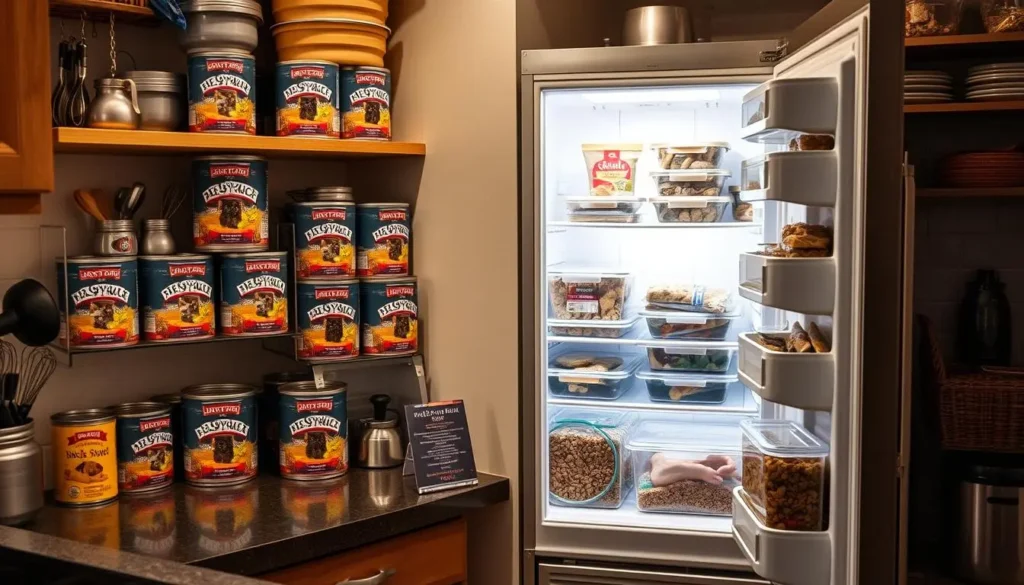
Storing wet dog food well is important to avoid spoilage and keep it safe. Your dog’s health depends on how well you store and handle their food.
Refrigeration and Storage Techniques
- Always store unopened cans in a cool, dry place
- Check expiration dates before purchasing
- Keep cans away from direct sunlight and heat sources
- Store at room temperature until opening
Managing Opened Wet Dog Food
After opening a can of wet dog food, follow these important steps:
- Refrigerate unused portions right away
- Use opened wet food within 3-5 days
- Cover the can with a tight-fitting lid
- Store at 40°F or below
Identifying Food Spoilage
Look out for these signs that your wet dog food has spoiled:
- Unusual odors different from normal smell
- Visible mold growth
- Discoloration or changes in texture
- Unusual separation of ingredients
“Keeping your dog’s food fresh is not just about taste, it’s about their health and safety.” – Veterinary Nutrition Expert
By following these storage tips, you’ll make sure your dog gets safe, nutritious meals every time you open a can of wet dog food.
Special Dietary Needs and Restricted Diets
Finding the right food for dogs with special needs can be tough. This is especially true for senior dogs. They often need special nutrition because of their health issues.
Dogs with health problems need food that’s just right for them. The best wet dog food for seniors, as seen on Reddit, has special health benefits. It’s important to know what your dog needs to stay healthy.
- Food Allergies: Look for limited ingredient wet foods
- Sensitive Digestive Systems: Seek easily digestible protein sources
- Kidney Disease: Low phosphorus and controlled protein diets
- Diabetes: Low-carbohydrate wet food options
Always talk to a vet before changing your dog’s diet. Not all specialized diets are created equal.
“Every dog’s nutritional needs are as unique as their personality” – Veterinary Nutrition Experts
| Health Condition | Recommended Wet Food Characteristics |
|---|---|
| Kidney Disease | Low phosphorus, controlled protein levels |
| Diabetes | Low carbohydrate, high protein content |
| Food Allergies | Single protein source, limited ingredients |
Prescription diets are key for managing health issues. These special wet foods are made to meet your dog’s specific needs. They offer health benefits that regular dog food can’t.
Transitioning Your Dog to Wet Food
Switching your dog’s diet to wet food needs careful planning and patience. The right wet food can be great for your dog’s health. But, introducing it must be done carefully to keep your pet’s digestive system healthy.
It’s not just about picking the best dog food. How you introduce it is key. A slow transition helps avoid digestive problems and makes sure your dog gets used to the new food.
Gradual Introduction Methods
To smoothly switch to wet food, follow these steps:
- Start by mixing a small amount of wet food with existing dry kibble
- Gradually increase the wet food proportion over 7-10 days
- Begin with a 25% wet food to 75% dry food ratio
- Increase wet food by 25% every two to three days
Monitoring Your Dog’s Response
Watching your dog closely is important during diet changes. Look for these signs:
- Stool consistency and frequency
- Energy levels
- Appetite changes
- Skin and coat condition
“A slow and steady approach prevents digestive upset and helps your dog adapt to new nutrition.” – Veterinary Nutrition Expert
Pro tip: If you notice persistent digestive issues or significant changes in behavior, consult your veterinarian immediately.
Remember, every dog is different. What works for one might not work for another. Be patient and watch your dog closely during this change.
Conclusion
Choosing the best wet dog food is important. It affects your dog’s health, energy, and how long they live. This guide helps you make choices that keep your dog happy and healthy.
Remember, every dog is different. Their diet should match their age, breed, how active they are, and any health issues. Always talk to your vet to find the right food for your dog.
Choosing quality wet dog food shows you care about your pet’s health. Look for foods with good nutrients, balanced ingredients, and your dog’s favorite flavors. This can make your dog’s life better, keeping them happy and full of energy.
Keep learning and watch how your dog reacts to new foods. Being active in their nutrition helps them stay well for a long time. The right food is key to your dog’s health and happiness.
FAQ
What makes wet dog food different from dry kibble?
Best wet dog food has more moisture, which helps with hydration and digestibility. It also tastes better and has more protein and fewer preservatives. This makes it a nutritious choice for many dogs.
How often should I feed my dog wet food?
Feeding frequency depends on your dog’s age, size, and health. You can feed wet food once or twice a day. It’s best to mix it with dry kibble or consult a vet for the right amount.
Is wet dog food more expensive than dry food?
Wet dog food costs more per serving than dry kibble. But, many owners find it’s worth it for the better nutrition and taste. You can save money by mixing it with dry food or choosing affordable premium brands.
Can wet dog food help with my senior dog’s appetite?
Yes, wet dog food is great for senior dogs. It smells better, is easier to chew, and can help older dogs eat more. This is especially true for dogs with smell loss or dental problems.
How long can an opened can of wet dog food be stored?
Store opened wet dog food in the fridge for 3-5 days. Use a tight lid or transfer it to an airtight container. This keeps it fresh and prevents bacteria.
Are there grain-free wet dog food options?
Yes, many brands offer grain-free wet dog food. It’s good for dogs with grain sensitivities or special diets. Always check the ingredients and talk to your vet to make sure it’s right for your dog.
How do I transition my dog to wet food?
Start by mixing 25% wet food with their current diet. Gradually increase the wet food over 7-10 days. Watch for any digestive issues or changes in energy and health.
Can wet dog food help with my dog’s hydration?
Absolutely. Wet dog food has 70-80% moisture, helping your dog stay hydrated. It’s especially good for dogs who don’t drink enough water or live in hot places.
What should I look for when choosing wet dog food?
Look for high-quality protein as the first ingredient and minimal artificial additives. Make sure it meets AAFCO standards and suits your dog’s life stage and health needs.
Is wet dog food suitable for puppies?
Yes, many wet dog foods are made for puppies. They provide the protein and calories needed for growth. Choose a puppy-specific wet food that supports their development and provides essential nutrients.

